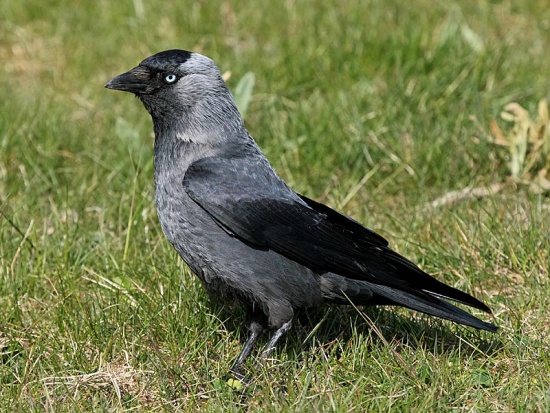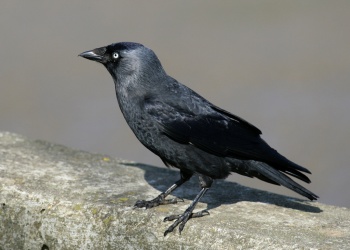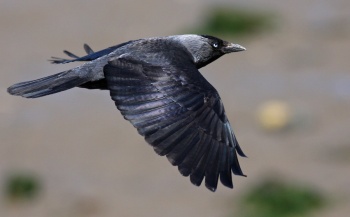Nutcracker (talk | contribs) m (format error) |
(Additional video link) |
||
| Line 48: | Line 48: | ||
<br /> | <br /> | ||
{{Video|Eurasian_Jackdaw}} | {{Video|Eurasian_Jackdaw}} | ||
| + | <br /> | ||
| + | {{Video|Common_Jackdaw Use "Common Jackdaw" to}} | ||
[[Category:Birds]][[Category:Corvus]][[Category:Bird Songs]][[Category:Videos]] [[Category:Coloeus]] | [[Category:Birds]][[Category:Corvus]][[Category:Bird Songs]][[Category:Videos]] [[Category:Coloeus]] | ||
Revision as of 19:25, 9 November 2015
- Corvus monedula
Identification
- Black plumage
- Blue-black metallic sheen on back and shoulders
- Grey nape and ear patches; paler grey in eastern subspecies
- Pale blue-green iris
- Short, pointed bill
Sexes similar. Juveniles have a dark iris at first, and a softer, tinged-brownish plumage without gloss.
Similar species
Immature Daurian Jackdaws look similar to this species, but more solidly black on the head.
Distribution
Found in most of Europe, patchily in northern Africa, the Middle East and western and central Asia.
Accidental vagrant to northeastern United States and Canada.
Abundant in most of its range; populations decreased in most western European countries in the past but have now mostly recovered.
Taxonomy
Subspecies
This is a polytypic species, consisting of four subspecies[1]:
- C. m. monedula:
- Scandinavia; occasionally winters to England and France
- C. m. spermologus:
- Western and central Europe; winters to the Canary Islands and Corsica
- C. m. soemmerringii:
- C. m. cirtensis:
Habitat
Breeds in large holes in trees, or on cliffs, quarries, and buildings, also parks with open woodlands. Winters in open farmland.
Behaviour
They can form large winter roosts, often along with Rooks.
Diet
The diet includes insects, amphibians, rodents, seeds, fruits, berries, reptiles, eggs and young birds.
Breeding
Breeding season starts in late April. Pairs stay together for several years. Usually several pairs are nesting in close proximity on rooftop chimneys, in caves and quarries. The nests are untidy stick structures. They will use long nest boxes. Lays 3-8 (average 4) eggs.
Vocalisation
Call: a ringing kyow, also chiak.
<flashmp3>Corvus monedula (song).mp3</flashmp3>
Listen in an external program
References
- Clements, J. F., T. S. Schulenberg, M. J. Iliff, B.L. Sullivan, C. L. Wood, and D. Roberson. 2012. The eBird/Clements Checklist of Birds of the World. 6th ed., with updates to October 2012. Ithaca: Cornell Univ. Press. ISBN 978-0801445019. Spreadsheet available at http://www.birds.cornell.edu/clementschecklist/downloadable-clements-checklist
- Del Hoyo, J, A Elliott, and D Christie, eds. 2009. Handbook of the Birds of the World. Volume 14: Bush-shrikes to Old World Sparrows. Barcelona: Lynx Edicions. ISBN 978-8496553507
- BF Member observations
- Whatbird
Recommended Citation
- BirdForum Opus contributors. (2024) Eurasian Jackdaw. In: BirdForum, the forum for wild birds and birding. Retrieved 3 May 2024 from https://www.birdforum.net/opus/Eurasian_Jackdaw
External Links






